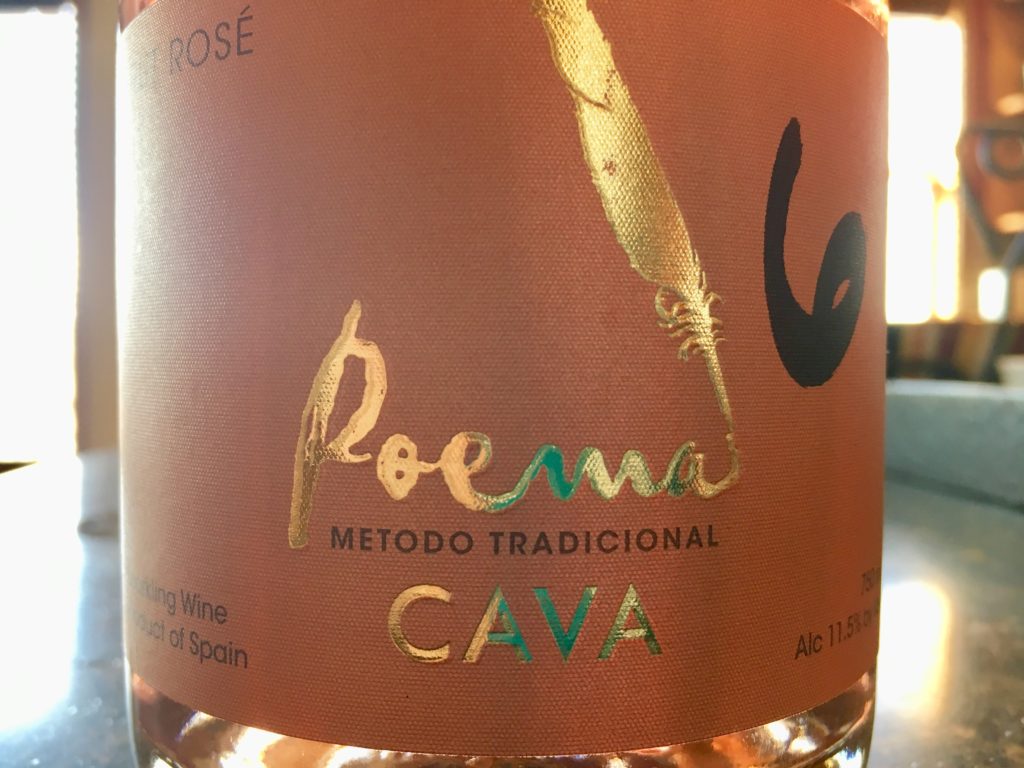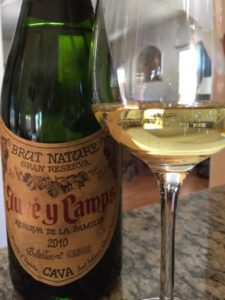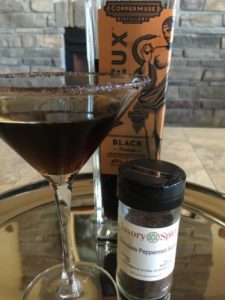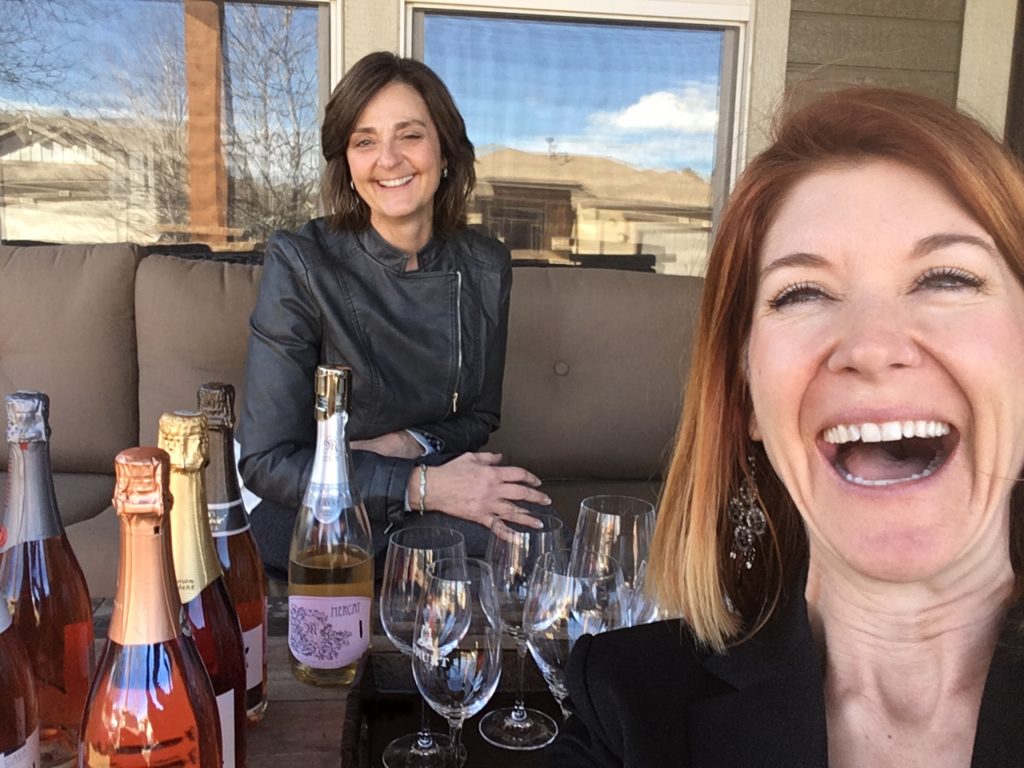Episode 150: Burning Wine Questions, a Cava Convo & Celebrations
Carving out a cava convo in response to a listener’s burning wine question, we dove in to some more bubbly banter. Who knew this discussion would lead to the Festa de la Filox-era (bring your bug costumes) and a sparkling Spanish sipper that garners $200/bottle? Steph creates a new cocktail, Val gets her haiku on, and a patron supporter wins some swell swag.
Burning Wine Question (1:00)
We’re shaking it up a bit and starting with the burning wine question.
This question is from David and asked us “What’s your favorite rosé cava?”
Of course, we answer the question by drinking. Because that’s how we roll. This is what inspired the cava convo happening in this week’s podcast.
In the Glasses This Week (1:30)
Steph: She’s tasting six cavas this week. She went skulking around Fort Collins and bought all the rosé cavas she could find at her two favorite liquor stores.
Her favorite, and sipping sidekick (and show supporter) Janet’s, was the Poema Rosé Brut Cava, even after all the bubbles subsided, it was still a delicious still wine.
They also singled out the Mercat. It was unlike all the others in color, taste and overall sensory experience. While she wouldn’t recommend the Mercat when someone has a rosé cava in mind, it is terrific as a bubbly aperitif or inexpensive alternative to champagne.
Here are the others she rounded up:
- Biutiful Brut Rosé Cava by Isaac Fernandez Seleccion – $11.79
- Segura Viudas Rosé Cava $7.91
- Mercat Brut Rosé Cava $12.31
- Casteller Brut Rosé Cava – $11.43
- German Gilabert Rosé Brut Nature Cava – $13.19
- She was drinking this back on Episode #69 with special guest Suzanne Hoffman. But this go round, the bottle was off and possibly corked. Total bummer!
- Poema Brut Rosé Cava – Trepat $11.43
You also cannot beat those prices for a little porch sipping, which was what Steph and the ladies were doing – in February – in Colorado. Go figure.
Val: Thought she had the 100% Pinot Noir Juvé y Camps in the cellar, but realized she “only” had vintage cava. But she jumped on the grenade for you guys and opened the 2010 Brut Nature Juvé y Camps, Reserve de la Familia.
It’s made with the three main grapes, Macabeo, Parellada, and Xarel-lo, but some Chardonnay – all free-run, first press juice from hand-harvested grapes.
Quick factoid on this brand – this is the one that is usually poured at banquets for Spain’s royal family.
Let’s Have a Cava Convo
What it is (6:15)
According to Spanish Wines.org, cava has an official definition: “A quality sparkling wine produced in a designated region.” They have to be made in the traditional method to be called cava, otherwise they are just “vino espumosos” or sparkling wines.
The word cava means “cave,” and while it does come from specified areas of Spain, it does refer more to a style of wine, specifically, traditional method sparkling.
History (7:30)
Cava’s history dates back to the late 1800s and the Catalan Agricultural Institute of San Isidro. Two sparkling wine makers were trying to make wine for the 1868 Paris Expo. Back then they were using the traditional grapes of Champagne, however, the following year, Penedes took a hit from phylloxera.
Every year in Penedes the phylloxera epidemic is celebrated because it ushered in the change that made cava possible today – a shift from red to white grape-dominated vineyards, and a focus on quality sparkling wine for which the region is now known! It’s called the “Festa de la Fil-loxera;” bring your bug costumes. #FestaDeLaFil-loxera is held the second week in September.
In the 1950’s and 1960’s, more sparkling wine regulation was enacted and refined. This included production of classic method, tank, and carbonated wines. In 1959 the word “cava” came on the scene as a style of wine.
However, In 1972 the newly created Consejo Regulador de los Vinos Espumosos, a governing body for sparkling wine production, gave cava its own set of production rules. The main purpose of this was to distinguish it from the champagne wine from the Champagne region.
Yet, cava didn’t receive its DO (Dominacion de Origen) until 1986, as well as its production zone.
In 2016 cava ushered in the age of a single-vineyard classification, Cava de Paraje Calificado (CPC).
Where cava comes from (12:15)
Ninety five percent of cava is produced south and east of Barcelona in Penedes. However, can cava come from the Rioja region? Yes it can. It can also come from Castilla y Leon, Aragon, Extramadura, Valencia, and Navarra.
There are over 240 producers. Only 12 are authorized to produce CPC, with nine producers actually releasing wines approved for the classification by the end of 2017, including the Juvé y Camps, and Gramona, which produces some top notch bubbly.
Cava grape gab (13:45)
Native grapes are at the core of cava production, precisely the Macabeo (Viura), Parellada, and Xarel-lo (Pansa Blanca). These are all white grapes, and Macabeo dominates with over 35% of the vineyard plantings.
Chardonnay is also authorized, along with Malvasia (Subirat Parent).
For the rosado or rosat (rosé), however, Pinot Noir, Garnacha, Monastrell (which is also Mourvedre) and Trepat are all used. We talked Trepat and other bubbly banter back in Episode #109.
Production (16:15)
As we mentioned earlier, it’s made with second fermentation in bottle, or classic or traditional method.
The differences between champagne and cava are not just the grapes, soil, and climate, but also the required minimum time on lees: for NV champagne it’s 15 months, for cava, both vintage and non-vintage, it’s a minimum of nine. Cava’s minimum abv is 10.8% with a max of 12.8%.
For Reservas and Gran Reservas minimum time on the lees is 15 and 30 months, respectively. Gran Reserva cava are vintage dated.
CPC
For CPC, time on lees is 36 months. Additionally, this is the single-vineyard, top quality, single-estate category. Also interesting is that the grapes not only have to be hand-picked, but they have to come from vines that are 10 years old or older, and there are yield restrictions.
Rosé
Rosado styles have to be made using sangrado (saignée) with an average six to nine hours macerations on the skins, not to exceed 15 hours, particularly as the climate in most cava-producing regions is Mediterranean. While blending of red wines is allowed in champagne, it is not permitted in cava.
Output
In 2017 (as of September) there were over 167 million bottles produced, with about 19 million Reserva, and just under two million Gran Reserva premium bottles – only 1/3rd of those are exported.
OUR burning wine question is, how much of this production is rosado? Inquiring wine podcasters want to know!
Styles (20:15)
Most Cavas are Non-Vintage (NV) and most of what you see in the US is the dry style otherwise known as Brut, but the Brut Nature and Extra Brut production has increased over the years.
In fact, the CPC can only be made in brut, extra brut, and brut nature styles.
Cava can be made in the sweeter styles to be labeled seco (dry), semiseco, and dulce (sweet). The latter is rare, and rarely produced now because of the increase in the dryer styles.
You can also get single varietal cava, like a Xarel-lo, Macabeo, and Trepat, as well as a Malvasia Cava Dessert Wine. A great #W25Challenge opportunity here, and definitely something to be served with dessert!
There are everyday cava wines available under $15; vintage and prestige bottlings can run up to $200.
Storing & service (24:45)
This brings us to a factoid conversation of the cava convo about vintage vs non-vintage wine, whether we’re talking still or sparkling. In this case, we are discussing cava, but you can apply this tidbit to all wine.
By nature of the term, non-vintage (NV) means that there’s no vintage date or year on the bottle. Okay, you might think that’s pretty benign and simple, but how old is that wine inside? How long has the retailer been hanging on to the bottle? Or, out of sight – out of mind, how long have you had that bottle?
Well, non-vintage wine is not meant for aging. It is designed to be opened and enjoyed in its youth. It should be fresh and expressive. Period. Know this and be aware when you’re buying cava and when you’re storing it. Val’s drinking a vintage 2010 cava which has the ability to age, versus the six bottles that Steph taste tested which should be popped and poured.
Serve Cava as you would Champagne, Prosecco or any sparkling wine, chilled at 45 degrees F (7 degrees C). Did you know the fastest way to chill a bottle of wine is with a ice water bath? The water is the important detail. It’s a lot faster than the fridge or freezer method, and works in 20 minutes or less. Adding salt to the water bath also makes a big difference.
And then there’s the glassware/stemware. Nowadays, anything goes as people are drinking bubbly wine in whatever glass fits their mood. We often use the same shaped tulip glass universally for all wines. But the flute is the traditional way to serve cava, for now.
Keep the cava convo cranking (30:00)
Consejo Regulador del Cava http://www.docava.es/en/ (most current regulatory information)
Institut del Cava: http://www.institutdelcava.com/
Wines from Spain (recommended by Rick Fischer in Episode 145) http://winesfromspainusa.com/?s=Cava
Wine Wit and Wisdom from the Society of Wine Educators http://winewitandwisdomswe.com//?s=cava
Webinars on Wine Scholar Guild – https://www.winescholarguild.org/past-member-webinar-video-recordings-9/regional-studies-6/spanish-wine-101/the-key-white-grapes-of-spain.html
Wino Radar (31:15)
We celebrate practically everything on this show. Each week is like a little celebration for us. Therefore, we are celebrating the 150th straight week of podcast releases, each and every Thursday. Therefore, we offer up a cocktail and a haiku.
A new cocktail (31:53)
Steph created a new cocktail for Wine Two Fivers.
The drink is called A Muse Me, a black martini with a black sugared rim.
- 1 ½ oz Copper Muse “Vicieux” Black Vodka
- ½ oz peppermint schnapps
- ¼ oz creme de cacao
- ¼ oz simple syrup
Rim the glass with Savory Spice chocolate peppermint sugar rim.
Shake the four ingredients with ice in a cocktail shaker and pour into a chilled martini glass with the sugared rim.
The black vodka is from a local Fort Collins distillery. Vicieux (vis-you) means vicious in French. The black sugar is from a favorite local spice shop. As you can imagine from the ingredient list, the drink is semi-sweet, semi-spicy like an intense breath mint, strong and mysterious. The chocolate is barely noticeable but balances the peppermint. The sugar rim gives texture and visual appeal.
Happy 150th Episode! We hope that we’ve amused you and continue to do so.
A new haiku (34:45)
Val’s making us all smile with … a haiku
Eh hem.
It’s not five o’clock
And we? We just do not care.
Wine Two Five Podcast
We know. All that lack of talent. Still amused?
Shoutouts (38:14)
We gave a shoutout to Genobigia for the review on iTunes Italy. You can read the review in last week’s blog. It was turned up in a scrub of international iTunes site, and we talk about what this review means to us in terms of capturing our mission and vision for the Wine Two Five Podcast. “Great crack” indeed.
Patreon Love (39:23)
Thank you to our Patrons who support us on the crowdfunding platform called Patreon!
“TENacious Tasters”
- Jeff E from the We Like Drinking podcast
- Lynn from Savor the Harvest blog
- Sebastian of Sassi Italy Tours
- Jen in Maryland (and the world, according to her Instagram feed)
- David and Lisa in Illinois
- Ann Marie in Virginia
“It’s not five o’clock and we don’t care” Listeners
- Meg in South Dakota
- Clay in Arizona
- In California – Jon, Andrew, Aswani
- Chantel in Ontario, Canada
- Mary Lou in Pennsylvania
- Cathie in Georgia
- In Colorado – Chris and Janet, Diane
- In Illinois – Steve, Renee
- Cathey in Tennessee
- Ashley in North Carolina
- Sean in Ohio
“Tastemaker Listeners”
- David in Scotland
- Carole in Kentucky
- Karen in California
Patreon perks (41:08)
The winner of this month’s drawing is Aswani! Aswani has been a long-time supporter of the show and gets to choose between a T-shirt or Govino glass.
Connect: (42:16)
We’re here for you every week. Between episodes you can find us on the social spaces @WineTwoFive and we encourage you to join our private FaceBook group called Wine Two Five Community!
Connect with Val on Twitter @WineGalUnboxed and as Vino With Val on Facebook, Instagram & Pinterest.
Connect with Steph on online as @TheWineHeroine.

